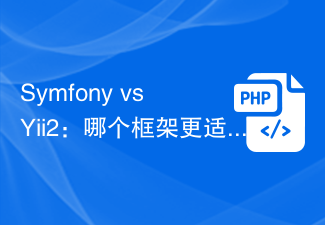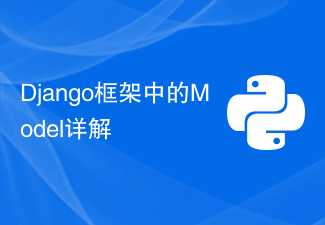 Backend Development
Backend Development PHP Tutorial
PHP Tutorial Detailed examples of Yii model query techniques based on arrays and objects, yiimodel_PHP tutorial
Detailed examples of Yii model query techniques based on arrays and objects, yiimodel_PHP tutorialDetailed examples of Yii's array- and object-based Model query techniques, yiimodel
This article describes Yii's array- and object-based Model query techniques with examples. Share it with everyone for your reference, the details are as follows:
For a Model Post, there are the following 4 query methods, which return objects or object arrays.
//查找满足指定条件的结果中的第一行 find the first row satisfying the specified condition $post=Post::model()->find($condition,$params); //查找具有指定主键值的那一行 find the row with the specified primary key $post=Post::model()->findByPk($postID,$condition,$params); //查找具有指定属性值的行 find the row with the specified attribute values $post=Post::model()->findByAttributes($attributes,$condition,$params);//未找到返回null //通过指定的SQL 语句查找结果中的第一行 find the first row using the specified SQL statement $post=Post::model()->findBySql($sql,$params);
If the find method finds a row that meets the query conditions, it will return a Post instance whose attributes contain the values of the corresponding columns in the data table row. Then we can read the loaded value like a normal object property, such as echo $post->title;. The find method will return null if nothing is found in the database using the given query criteria.
When calling find, we use $condition and $params to specify the query conditions. Here $condition can be a WHERE string in the SQL statement and $params is an array of parameters whose values should be bound to the placeholders in $condation. For example: Suppose we query the data with postID = 10
// find the row with postID=10
$post=Post::model()->find('postID=:postID', array(':postID'=>10));
The condition $condition is the where part in our sql. What about the parameters? They are passed through params, but the name is added with ":".
YII has a CDbCriteria class to construct queries. If we query the title with a postId of 10, CdbCriteria is constructed like this
$criteria=new CDbCriteria;
$criteria->select='title'; // only select the 'title' column
$criteria->condition='postID=:postID';
$criteria->params=array(':postID'=>10);
$post=Post::model()->find($criteria); // $params is not needed
An alternative to CDbCriteria is to pass an array to the find method. The keys and values of the array respectively correspond to the attribute names and values of the criterion. The above example can be rewritten as follows:
$post=Post::model()->find(array(
'select'=>'title',
'condition'=>'postID=:postID',
'params'=>array(':postID'=>10),
));
Of course also applies to findAll()
self::$_items[$type]=array();
$models=self::model()->findAll(array(
'condition'=>'type=:type',
'params'=>array(':type'=>$type),
'order'=>'position',
));
When a query condition is about matching several columns by specified values, we can use findByAttributes(). We make the $attributes parameter an array of values indexed by column name.
$attributes in findByAttributes is the name of the field. How to query if the title is abc? See below
Copy code The code is as follows: Post::model()->findByAttributes(array('title'=>'abc'))
Other methods:
1. $admin=Admin::model()->findAll($condition,$params);
This method is to query a collection based on a condition, such as:
Copy code The code is as follows: findAll("username=:name",array(":name"=>$username));
2. $admin=Admin::model()->findAllByPk($postIDs,$condition,$params);
findAllByPk($id,"name like ':name' and age=:age" ,array(':name'=>$name,'age'=>$age));
This method is to query a collection based on the primary key. Multiple primary keys can be used, such as:
Copy code The code is as follows: findAllByPk(array(1,2));
3. $admin=Admin::model()->findAllByAttributes($attributes,$condition,$params);
This method is to query a collection based on conditions, which can be multiple conditions. Put the conditions into an array, such as:
Copy code The code is as follows: findAllByAttributes(array('username'=>'admin'));
4. $admin=Admin::model()->findAllBySql($sql,$params);
This method is to query an array based on a SQL statement, such as:
Copy code The code is as follows: findAllBySql("select *from admin where username=:name",array(':name'=>'admin'));
2. Method of querying objects
1. $admin=Admin::model()->findByPk($postID,$condition,$params);
Query an object based on the primary key, such as: Copy code The code is as follows: findByPk(1);
2. $row=Admin::model()->find($condition,$params);
Query a set of data based on a condition, there may be multiple data, but it only returns the first row of data, such as:
Copy code The code is as follows: find('username=:name',array(':name'=>'admin'));
3. $admin=Admin::model()->findByAttributes($attributes,$condition,$params);
This method is to query a set of data based on conditions, which can be multiple conditions. Put the conditions into the array, and it will also query the first piece of data, such as:
Copy code The code is as follows: findByAttributes(array('username'=>'admin'));
4. $admin=Admin::model()->findBySql($sql,$params);
This method is to query a set of data based on SQL statements. It also queries the first piece of data, such as:
Copy code The code is as follows: findBySql("select *from admin where username=:name",array(':name'=>'admin'));
5. Put together a method to obtain SQL, and query an object based on find
$criteria=new CDbCriteria;
$criteria->select='username'; // only select the 'title' column
$criteria->condition='username=:username';
$criteria->params=array(':username=>'admin');
$post=Post::model()->find($criteria); // $params is not needed
3. Query the number and determine whether the query has results
1. $n=Post::model()->count($condition,$params);
该方法是根据一个条件查询一个集合有多少条记录,返回一个int型数字,如
复制代码 代码如下:count("username=:name",array(":name"=>$username));
2、$n=Post::model()->countBySql($sql,$params);
该方法是根据SQL语句查询一个集合有多少条记录,返回一个int型数字,如
复制代码 代码如下:countBySql("select *from admin where username=:name",array(':name'=>'admin'));
3、$exists=Post::model()->exists($condition,$params);
该方法是根据一个条件查询查询得到的数组有没有数据,如果有数据返回一个true,否则没有找到
四、添加的方法
$admin=new Admin;
$admin->username=$username;
$admin->password=$password;
if($admin->save()>0){
echo "添加成功";
}else{
echo "添加失败";
}
五、修改的方法
1、Post::model()->updateAll($attributes,$condition,$params);
$count = Admin::model()->updateAll(array('username'=>'11111','password'=>'11111'),'password=:pass',array(':pass'=>'1111a1'));
if($count>0){
echo "修改成功";
}else{
echo "修改失败";
}
2、Post::model()->updateByPk($pk,$attributes,$condition,$params);
$count = Admin::model()->updateByPk(1,array('username'=>'admin','password'=>'admin'));
$count = Admin::model()->updateByPk(array(1,2),array('username'=>'admin','password'=>'admin'),'username=:name',array(':name'=>'admin'));
if($count>0){
echo "修改成功";
}else{
echo "修改失败";
}
$pk代表主键,可以是一个也可以是一个集合,$attributes代表是要修改的字段的集合,$condition代表条件,$params传入的值
3、Post::model()->updateCounters($counters,$condition,$params);
$count =Admin::model()->updateCounters(array('status'=>1),'username=:name',array(':name'=>'admin'));
if($count>0){
echo "修改成功";
}else{
echo "修改失败";
}
array('status'=>1)代表数据库中的admin表根据条件username='admin',查询出的所有结果status字段都自加1
六、删除的方法
1、Post::model()->deleteAll($condition,$params);
$count = Admin::model()->deleteAll('username=:name and password=:pass',array(':name'=>'admin',':pass'=>'admin'));
$id=1,2,3
deleteAll('id in(".$id.")');删除id为这些的数据
if($count>0){
echo "删除成功";
}else{
echo "删除失败";
}
2、Post::model()->deleteByPk($pk,$condition,$params);
$count = Admin::model()->deleteByPk(1);
$count = Admin::model()->deleteByPk(array(1,2),'username=:name',array(':name'=>'admin'));
if($count>0){
echo "删除成功";
}else{
echo "删除失败";
}
希望本文所述对大家基于Yii框架的PHP程序设计有所帮助。
您可能感兴趣的文章:
- PHP YII框架开发小技巧之模型(models)中rules自定义验证规则
- Yii2使用小技巧之通过 Composer 添加 FontAwesome 字体资源
- YiiFramework入门知识点总结(图文教程)
- PHP的Yii框架的常用日志操作总结
- Yii学习总结之数据访问对象 (DAO)
- Yii学习总结之安装配置
- YII路径的用法总结
- Yii使用技巧大汇总
 Trezor冷钱包:Model One与Model T的特性和使用指南Jan 19, 2024 pm 04:12 PM
Trezor冷钱包:Model One与Model T的特性和使用指南Jan 19, 2024 pm 04:12 PM在许多中心化交易所出现问题后,越来越多的币圈投资者开始将资产转移到冷钱包中,以减少中心化交易所带来的风险。本文将介绍全球最早的冷钱包供应商Trezor,自2014年推出首款冷钱包至今,在全球多个国家销售。Trezor的产品包括2014年推出的ModelOne和2018年推出的进阶版本ModelT。下面将继续介绍这两款产品与其他冷钱包的区别。什么是Trezor冷钱包?2014年,Trezor推出了第一款冷钱包ModelOne。除了常见的BTC、ETH、USDT等币种外,该钱包还支持超过1000种其
 如何使用PHP框架Yii开发一个高可用的云备份系统Jun 27, 2023 am 09:04 AM
如何使用PHP框架Yii开发一个高可用的云备份系统Jun 27, 2023 am 09:04 AM随着云计算技术的不断发展,数据的备份已经成为了每个企业必须要做的事情。在这样的背景下,开发一款高可用的云备份系统尤为重要。而PHP框架Yii是一款功能强大的框架,可以帮助开发者快速构建高性能的Web应用程序。下面将介绍如何使用Yii框架开发一款高可用的云备份系统。设计数据库模型在Yii框架中,数据库模型是非常重要的一部分。因为数据备份系统需要用到很多的表和关
 Yii框架中的数据查询:高效地访问数据Jun 21, 2023 am 11:22 AM
Yii框架中的数据查询:高效地访问数据Jun 21, 2023 am 11:22 AMYii框架是一个开源的PHPWeb应用程序框架,提供了众多的工具和组件,简化了Web应用程序开发的流程,其中数据查询是其中一个重要的组件之一。在Yii框架中,我们可以使用类似SQL的语法来访问数据库,从而高效地查询和操作数据。Yii框架的查询构建器主要包括以下几种类型:ActiveRecord查询、QueryBuilder查询、命令查询和原始SQL查询
 php如何使用Yii3框架?May 31, 2023 pm 10:42 PM
php如何使用Yii3框架?May 31, 2023 pm 10:42 PM随着互联网的不断发展,Web应用程序开发的需求也越来越高。对于开发人员而言,开发应用程序需要一个稳定、高效、强大的框架,这样可以提高开发效率。Yii是一款领先的高性能PHP框架,它提供了丰富的特性和良好的性能。Yii3是Yii框架的下一代版本,它在Yii2的基础上进一步优化了性能和代码质量。在这篇文章中,我们将介绍如何使用Yii3框架来开发PHP应用程序。
 Yii2 vs Phalcon:哪个框架更适合开发显卡渲染应用?Jun 19, 2023 am 08:09 AM
Yii2 vs Phalcon:哪个框架更适合开发显卡渲染应用?Jun 19, 2023 am 08:09 AM在当前信息时代,大数据、人工智能、云计算等技术已经成为了各大企业关注的热点。在这些技术中,显卡渲染技术作为一种高性能图形处理技术,受到了越来越多的关注。显卡渲染技术被广泛应用于游戏开发、影视特效、工程建模等领域。而对于开发者来说,选择一个适合自己项目的框架,是一个非常重要的决策。在当前的语言中,PHP是一种颇具活力的语言,一些优秀的PHP框架如Yii2、Ph
 Symfony vs Yii2:哪个框架更适合开发大型Web应用?Jun 19, 2023 am 10:57 AM
Symfony vs Yii2:哪个框架更适合开发大型Web应用?Jun 19, 2023 am 10:57 AM随着Web应用需求的不断增长,开发者们在选择开发框架方面也越来越有选择的余地。Symfony和Yii2是两个备受欢迎的PHP框架,它们都具有强大的功能和性能,但在面对需要开发大型Web应用时,哪个框架更适合呢?接下来我们将对Symphony和Yii2进行比较分析,以帮助你更好地进行选择。基本概述Symphony是一个由PHP编写的开源Web应用框架,它是建立
 yii如何将对象转化为数组或直接输出为json格式Jan 08, 2021 am 10:13 AM
yii如何将对象转化为数组或直接输出为json格式Jan 08, 2021 am 10:13 AMyii框架:本文为大家介绍了yii将对象转化为数组或直接输出为json格式的方法,具有一定的参考价值,希望能够帮助到大家。
 Django框架中的Model详解Jun 17, 2023 am 08:48 AM
Django框架中的Model详解Jun 17, 2023 am 08:48 AMDjango是一个开源的Pythonweb框架,它采用了MVT(Model-View-Template)的架构模式,将应用程序分为模型(Model)、视图(View)和模板(Template)三个部分。其中,Model是Django框架中的一个基础组件,用于对数据进行定义和管理。本文将对Django框架中的Model进行详解。什么是Model在Django


Hot AI Tools

Undresser.AI Undress
AI-powered app for creating realistic nude photos

AI Clothes Remover
Online AI tool for removing clothes from photos.

Undress AI Tool
Undress images for free

Clothoff.io
AI clothes remover

AI Hentai Generator
Generate AI Hentai for free.

Hot Article

Hot Tools

mPDF
mPDF is a PHP library that can generate PDF files from UTF-8 encoded HTML. The original author, Ian Back, wrote mPDF to output PDF files "on the fly" from his website and handle different languages. It is slower than original scripts like HTML2FPDF and produces larger files when using Unicode fonts, but supports CSS styles etc. and has a lot of enhancements. Supports almost all languages, including RTL (Arabic and Hebrew) and CJK (Chinese, Japanese and Korean). Supports nested block-level elements (such as P, DIV),

ZendStudio 13.5.1 Mac
Powerful PHP integrated development environment

Zend Studio 13.0.1
Powerful PHP integrated development environment

SublimeText3 Chinese version
Chinese version, very easy to use

Safe Exam Browser
Safe Exam Browser is a secure browser environment for taking online exams securely. This software turns any computer into a secure workstation. It controls access to any utility and prevents students from using unauthorized resources.






